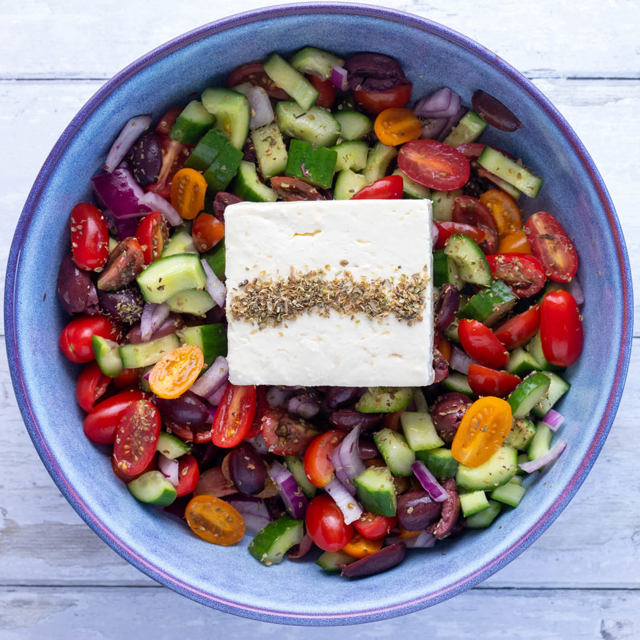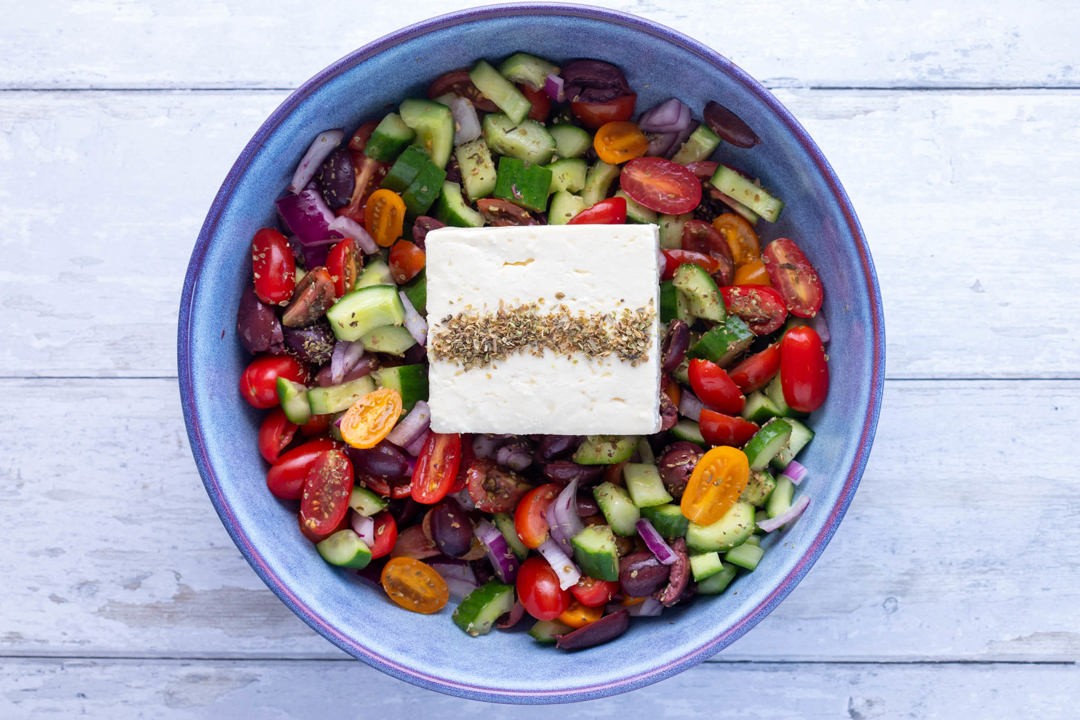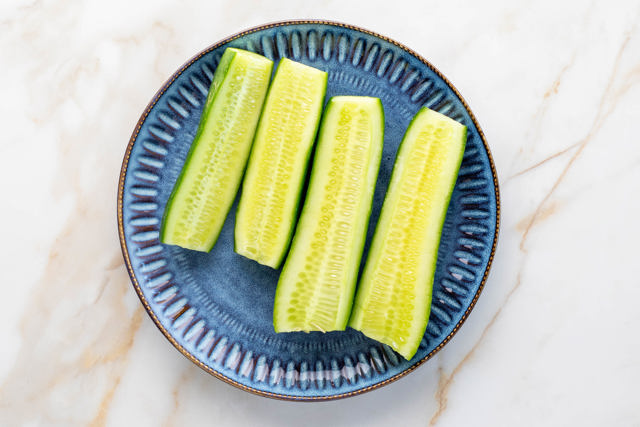If you've read many of my posts, you'll know that my favourite cuisine is Greek. For me, a Greek salad - and btw they do a lot of different salads - was the first Greek dish I remember eating.
Known in Greece as Horiatiki Salata which literally means "Village Salad," the name is evocative of a farmer eating quality Greek ingredients made with what they might have on hand.
Coming together from 4 simple salad ingredients: tomato, cucumber, red onion, olives and along with feta cheese, oil, vinegar and oregano - you can easily put a Greek salad together while cooking some protein to have on the side.
There are a lof of common additions made to the salad too, which can bulk it out and add extra flavours to it. I've listed these further below. It's really important to use the freshest and best quality ingredients that you can source for this salad - tomatoes in particular are really only good for a few months of the year.
What is Greek salad?
Also known as Horiatiki Salata - literally "Village Salad" - what we refer to as a Greek salad is made from tomato, cucumber, red onion, olives and feta, served with oregano and a red wine vinegar dressing.
Greek salad ingredients
- Tomatoes - use the best tomatoes you can which are in season. Some varieties I'd recommend are Roma or anything ripened on the vine. Wherever possible, avoid tomatoes which have been stored in the fridge because it alters the texture. I quite like to use cherry tomatoes as I have in this recipe because the quality is predictable year round.
- Cucumber - I like to use small cucumbers because I prefer the flavour. These are known in Australia as "Lebanese" cucumbers. If the cucumber you choose has a thick skin, I suggest either partially or completely peeling it. Whether you remove the seeds is up to you; if you want to, halve the cucumbers and run a spoon down while scooping into the seeds to remove them.
- Red onion - make sure you get an onion which isn't showing signs of sprouting - look out for dark spots, growth and softness.
- Kalamata olives - the quintessential Greek olive, wherever possible use olives in oil because the taste and texture is superior. Always check that pitted olives have completely had the pit removed. While it isn't traditional, I sometimes like to throw through some nice pitted Sicilian olives.
- Oregano - wherever possible, use Greek oregano.
- Extra virgin olive oil and red wine vinegar form the basis of the salad dressing
- Salt and pepper - used to season to taste. While the feta and olives are salty, the cucumber and tomato will suck that up.
How to make a Greek Salad
Prepare the vegetables
Olives - you can halve the olives or keep them whole. I like to halve them just in case the machine has not pitted them correctly.
Cucumber - cut in half lengthways (1). Optionally remove the seeds by using a spoon and scraping them out (2). Cut the halves lengthways into quarters and then slice crossways (3).
Tomatoes - cut into bite sized pieces or wedges. If you're using cherry tomatoes like me, cut the larger ones and leave the smaller ones whole.
Onion - the standard recipe uses about half a red onion. Cut the onion in half, remove the outer layer and then cut into 4 or 5 segments (1) and then cut across (2).
Feta - choose whether to serve the feta in the traditional way, which is placed on top of the vegetables and people help themselves when serving, or whether you want to cut it up or crumble it. I like it in all of those ways; if you want to cube it cut into approx 1.5cm cubes.
Make the salad
Place the tomato, olives, onion and cucumber into a salad bowl.
Place the feta on top (if leaving whole), or place the cubes into the bowl (if cubing), or crumble (if crumbling).
Add the oregano, red wine vinegar and extra virgin olive oil.
Season to taste with salt and pepper.
Tips
- Use ripe tomatoes which are in season. A safe fallback is cherry tomatoes.
- If you find red onion too pungent, soak in water for 10-15 minutes before patting dry with paper towel and adding to the salad. Wherever possible use a PDO (protected designation of origin) Greek feta cheese. The taste and texture will almost certainly be superior to non-PDO cheeses. Authentic Greek feta is made from sheep and/or goats milk which has a better flavour.
- If you can find them, use Greek Kalamata olives marinated in oil.
- As with any salad, dress immediately before serving.
What other ingredients are often added to a Greek salad?
These are commonly added ingredients to a Greek salad. While it's unlikely you'd find a Greek salad with all of these, adding an extra ingredient or so brings new flavours and lets you put your own spin on the dish:
- Green capsicum/bell pepper is very commonly added.
- Capers work well with the olives and bring a zesty flavour to the salad.
- Lemon juice in place of red wine vinegar, or replace part of the red wine vinegar with lemon juice.
- Pepperoncini - brings a mild chilli heat to the salad.
- Fresh herbs, namely parsley, mint or occasionally dill.
- In the United States, it's quite common for lettuce to be added. I'm not a fan, but you do you.
Can I bulk out a Greek salad to make it a complete meal?
Yes, try adding a can of drained and rinsed chickpeas. While it's not traditional it does add protein and it works well with the other ingredients.
It's quite common for Greek salads in the United State to feature lettuce. I'm not a fan, but if it works for you go for it.
Can I make Greek salad in advance?
Yes, but hold off dressing and adding the salt to the salad until just before serving. Consider removing the cucumber seeds if you're making it in advance as it can make the salad watery.
What to serve with Greek salad?
Greek salad packs nutrition in, so it works well when combined with a lean protein and optionally a grain.
It naturally pairs best with Mediterranean food.
Here's some suggestions:
- Grilled marinated Greek lemon chicken
- Greek-style marinated lamb cutlets
- Oven baked Green-style fish

Greek Village Salad "Horiatiki"
| Prep | Total |
|---|---|
| 10 mins | 10 mins |
- 300g tomatoes, cut into bite-sized pieces or wedges see note 1
- 250g cucumber, quartered and sliced I like small "Lebanese" style cucumbers; see note 2
- 60g red onion, finely sliced about half an onion, see note 3
- 80g Kalamata olives, halved preferably Greek and marinated in oil, see note 4
- 200g block feta cheese preferably Greek PDO cheese, see note 5
- 2 tbsp dried oregano preferably Greek oregano
- Salt and pepper, to taste
- 3 tbsp red wine vinegar or for lemon juice
- 4 tbsp extra-virgin olive oil preferably Greek
- Combine vegetables - add the tomato, cucumber, onion and olives to a salad bowl.
- Dressing - add the vinegar or lemon juice along with the extra virgin olive oil. Add half the oregano to the salad. Stir to combine.
- Feta - traditionally this is served as a whole block on top of the salad. You can leave the feta whole, crumble it or cut into cubes. If leaving whole, place on top of the vegetables and top with the remaining half of the oregano. If cubing or crumbling, add the remaining half of the oregano to the salad.
- Season to taste with salt and pepper.
- Tomatoes - use fresh tomatoes that are in season. I recommend Roma or anything ripened on the vine. I also like to use cherry tomatoes, as I have in this recipe. The tomatoes should be cut into bite sized pieces or wedges.
- Cucumber - I find the taste and texture of small cucumbers (known as Lebanese in Australia) work best. I also like to deseed them, which you can do by halving the cucumber lengthways and then using a spoon to scoop the seeds out. To quarter the cucumber, halve it lengthways and then cut the half in half lengthways.
- Red onion - red onions are relatively mild, but if you find them pungent soak them in cold water for 10 minutes before patting dry with paper towel.
- Olives - if using pitted, always make sure they're properly pitted! I like to halve them for this reason. Greek Kalamata olives, marinated in oil work best, but use brined olives if you can't get them in oil.
- Feta - feta is normally served as a whole block on top of the salad which people break apart while they serve themselves. You can crumble it or cube it if you'd prefer. A PDO Greek feta cheese is best if you can get it.




























